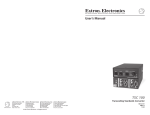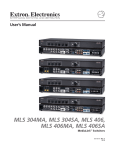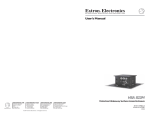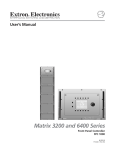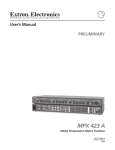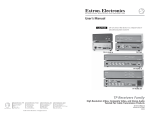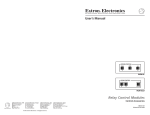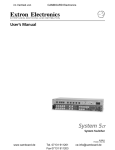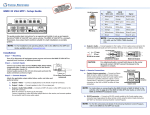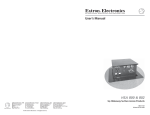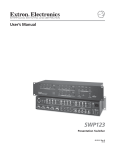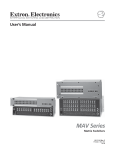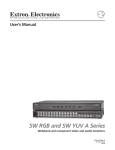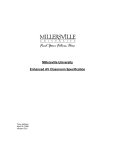Download Extron electronic MPS 112CS User's Manual
Transcript
MPS 112 and MPS 112CS Media Presentation Switchers 68-706-01 Rev. F 11 04 Precautions Safety Instructions • English This symbol is intended to alert the user of important operating and maintenance (servicing) instructions in the literature provided with the equipment. This symbol is intended to alert the user of the presence of uninsulated dangerous voltage within the product's enclosure that may present a risk of electric shock. Warning Power sources • This equipment should be operated only from the power source indicated on the product. This equipment is intended to be used with a main power system with a grounded (neutral) conductor. The third (grounding) pin is a safety feature, do not attempt to bypass or disable it. Caution Power disconnection • To remove power from the equipment safely, remove all power cords from the rear of the equipment, or the desktop power module (if detachable), or from the power source receptacle (wall plug). Read Instructions • Read and understand all safety and operating instructions before using the equipment. Power cord protection • Power cords should be routed so that they are not likely to be stepped on or pinched by items placed upon or against them. Retain Instructions • The safety instructions should be kept for future reference. Servicing • Refer all servicing to qualified service personnel. There are no user-serviceable parts inside. To prevent the risk of shock, do not attempt to service this equipment yourself because opening or removing covers may expose you to dangerous voltage or other hazards. Follow Warnings • Follow all warnings and instructions marked on the equipment or in the user information. Avoid Attachments • Do not use tools or attachments that are not recommended by the equipment manufacturer because they may be hazardous. Slots and openings • If the equipment has slots or holes in the enclosure, these are provided to prevent overheating of sensitive components inside. These openings must never be blocked by other objects. Lithium battery • There is a danger of explosion if battery is incorrectly replaced. Replace it only with the same or equivalent type recommended by the manufacturer. Dispose of used batteries according to the manufacturer's instructions. Consignes de Sécurité • Français Avertissement Ce symbole sert à avertir l’utilisateur que la documentation fournie avec le matériel contient des instructions importantes concernant l’exploitation et la maintenance (réparation). Alimentations• Ne faire fonctionner ce matériel qu’avec la source d’alimentation indiquée sur l’appareil. Ce matériel doit être utilisé avec une alimentation principale comportant un fil de terre (neutre). Le troisième contact (de mise à la terre) constitue un dispositif de sécurité : n’essayez pas de la contourner ni de la désactiver. Ce symbole sert à avertir l’utilisateur de la présence dans le boîtier de l’appareil de tensions dangereuses non isolées posant des risques d’électrocution. Déconnexion de l’alimentation• Pour mettre le matériel hors tension sans danger, déconnectez tous les cordons d’alimentation de l’arrière de l’appareil ou du module d’alimentation de bureau (s’il est amovible) ou encore de la prise secteur. Attention Lire les instructions• Prendre connaissance de toutes les consignes de sécurité et d’exploitation avant d’utiliser le matériel. Conserver les instructions• Ranger les consignes de sécurité afin de pouvoir les consulter à l’avenir. Respecter les avertissements • Observer tous les avertissements et consignes marqués sur le matériel ou présentés dans la documentation utilisateur. Eviter les pièces de fixation • Ne pas utiliser de pièces de fixation ni d’outils non recommandés par le fabricant du matériel car cela risquerait de poser certains dangers. Protection du cordon d’alimentation • Acheminer les cordons d’alimentation de manière à ce que personne ne risque de marcher dessus et à ce qu’ils ne soient pas écrasés ou pincés par des objets. Réparation-maintenance • Faire exécuter toutes les interventions de réparation-maintenance par un technicien qualifié. Aucun des éléments internes ne peut être réparé par l’utilisateur. Afin d’éviter tout danger d’électrocution, l’utilisateur ne doit pas essayer de procéder lui-même à ces opérations car l’ouverture ou le retrait des couvercles risquent de l’exposer à de hautes tensions et autres dangers. Fentes et orifices • Si le boîtier de l’appareil comporte des fentes ou des orifices, ceux-ci servent à empêcher les composants internes sensibles de surchauffer. Ces ouvertures ne doivent jamais être bloquées par des objets. Lithium Batterie • Il a danger d'explosion s'll y a remplacment incorrect de la batterie. Remplacer uniquement avec une batterie du meme type ou d'un ype equivalent recommande par le constructeur. Mettre au reut les batteries usagees conformement aux instructions du fabricant. Sicherheitsanleitungen • Deutsch Vorsicht Dieses Symbol soll dem Benutzer in der im Lieferumfang enthaltenen Dokumentation besonders wichtige Hinweise zur Bedienung und Wartung (Instandhaltung) geben. Stromquellen • Dieses Gerät sollte nur über die auf dem Produkt angegebene Stromquelle betrieben werden. Dieses Gerät wurde für eine Verwendung mit einer Hauptstromleitung mit einem geerdeten (neutralen) Leiter konzipiert. Der dritte Kontakt ist für einen Erdanschluß, und stellt eine Sicherheitsfunktion dar. Diese sollte nicht umgangen oder außer Betrieb gesetzt werden. Dieses Symbol soll den Benutzer darauf aufmerksam machen, daß im Inneren des Gehäuses dieses Produktes gefährliche Spannungen, die nicht isoliert sind und die einen elektrischen Schock verursachen können, herrschen. Stromunterbrechung • Um das Gerät auf sichere Weise vom Netz zu trennen, sollten Sie alle Netzkabel aus der Rückseite des Gerätes, aus der externen Stomversorgung (falls dies möglich ist) oder aus der Wandsteckdose ziehen. Achtung Lesen der Anleitungen • Bevor Sie das Gerät zum ersten Mal verwenden, sollten Sie alle Sicherheitsund Bedienungsanleitungen genau durchlesen und verstehen. Aufbewahren der Anleitungen • Die Hinweise zur elektrischen Sicherheit des Produktes sollten Sie aufbewahren, damit Sie im Bedarfsfall darauf zurückgreifen können. Befolgen der Warnhinweise • Befolgen Sie alle Warnhinweise und Anleitungen auf dem Gerät oder in der Benutzerdokumentation. Keine Zusatzgeräte • Verwenden Sie keine Werkzeuge oder Zusatzgeräte, die nicht ausdrücklich vom Hersteller empfohlen wurden, da diese eine Gefahrenquelle darstellen können. Instrucciones de seguridad • Español Schutz des Netzkabels • Netzkabel sollten stets so verlegt werden, daß sie nicht im Weg liegen und niemand darauf treten kann oder Objekte darauf- oder unmittelbar dagegengestellt werden können. Wartung • Alle Wartungsmaßnahmen sollten nur von qualifiziertem Servicepersonal durchgeführt werden. Die internen Komponenten des Gerätes sind wartungsfrei. Zur Vermeidung eines elektrischen Schocks versuchen Sie in keinem Fall, dieses Gerät selbst öffnen, da beim Entfernen der Abdeckungen die Gefahr eines elektrischen Schlags und/oder andere Gefahren bestehen. Schlitze und Öffnungen • Wenn das Gerät Schlitze oder Löcher im Gehäuse aufweist, dienen diese zur Vermeidung einer Überhitzung der empfindlichen Teile im Inneren. Diese Öffnungen dürfen niemals von anderen Objekten blockiert werden. Litium-Batterie • Explosionsgefahr, falls die Batterie nicht richtig ersetzt wird. Ersetzen Sie verbrauchte Batterien nur durch den gleichen oder einen vergleichbaren Batterietyp, der auch vom Hersteller empfohlen wird. Entsorgen Sie verbrauchte Batterien bitte gemäß den Herstelleranweisungen. Advertencia Este símbolo se utiliza para advertir al usuario sobre instrucciones importantes de operación y mantenimiento (o cambio de partes) que se desean destacar en el contenido de la documentación suministrada con los equipos. Alimentación eléctrica • Este equipo debe conectarse únicamente a la fuente/tipo de alimentación eléctrica indicada en el mismo. La alimentación eléctrica de este equipo debe provenir de un sistema de distribución general con conductor neutro a tierra. La tercera pata (puesta a tierra) es una medida de seguridad, no puentearia ni eliminaria. Este símbolo se utiliza para advertir al usuario sobre la presencia de elementos con voltaje peligroso sin protección aislante, que puedan encontrarse dentro de la caja o alojamiento del producto, y que puedan representar riesgo de electrocución. Desconexión de alimentación eléctrica • Para desconectar con seguridad la acometida de alimentación eléctrica al equipo, desenchufar todos los cables de alimentación en el panel trasero del equipo, o desenchufar el módulo de alimentación (si fuera independiente), o desenchufar el cable del receptáculo de la pared. Precaucion Leer las instrucciones • Leer y analizar todas las instrucciones de operación y seguridad, antes de usar el equipo. Conservar las instrucciones • Conservar las instrucciones de seguridad para futura consulta. Obedecer las advertencias • Todas las advertencias e instrucciones marcadas en el equipo o en la documentación del usuario, deben ser obedecidas. Evitar el uso de accesorios • No usar herramientas o accesorios que no sean especificamente recomendados por el fabricante, ya que podrian implicar riesgos. Protección del cables de alimentación • Los cables de alimentación eléctrica se deben instalar en lugares donde no sean pisados ni apretados por objetos que se puedan apoyar sobre ellos. Reparaciones/mantenimiento • Solicitar siempre los servicios técnicos de personal calificado. En el interior no hay partes a las que el usuario deba acceder. Para evitar riesgo de electrocución, no intentar personalmente la reparación/mantenimiento de este equipo, ya que al abrir o extraer las tapas puede quedar expuesto a voltajes peligrosos u otros riesgos. Ranuras y aberturas • Si el equipo posee ranuras o orificios en su caja/alojamiento, es para evitar el sobrecalientamiento de componentes internos sensibles. Estas aberturas nunca se deben obstruir con otros objetos. Batería de litio • Existe riesgo de explosión si esta batería se coloca en la posición incorrecta. Cambiar esta batería únicamente con el mismo tipo (o su equivalente) recomendado por el fabricante. Desachar las baterías usadas siguiendo las instrucciones del fabricante. Quick Start — MPS Series Installation Step 1 Turn off power to the MPS switcher and all other devices that will be connected. Mounting Screws (2 Plcs) Each Side Optional Furniture Mounting Bracket Step 2 MP (VI DE O) OU S 11 OG T PR OU 2 T 4 3 Select your mounting option and install the appropriate brackets. Mount the switcher. 2 (S- or EO 1 ) OU T 4 3 #8 Screw (4 Plcs) Each Side RS -23 T L AU DIO 1 A) C MI IN R 3 2 1 4 2 VG A TT OU OU 3 Step 3 VID EO OU Extron MPS 112 4 1 2 T 4 3 MAX 2 0.5A V 100 Attach up to four VGA, four S-video, and four Video (composite) input devices (up to four of each type) to the MPS switcher. VID 2 OU (VG -240 S-V 1 IDE O Media Presentation Switcher 0 Hz 50/6 Supplied Rack Mounting Bracket Mounting options Step 4 Connect a VGA output, an S-video output, and a Video (composite) output from the switcher to a projector’s inputs. Microphone Extron MPS 112CS Step 5 Media Presentation Switcher For stereo input, connect up to 12 audio sources to the audio inputs of the VGA, S-video, or Video (composite) groups (up to four audio sources for each group). See chapter two, Installation, for wiring diagrams. 2 MP (VI DE O) S 11 G OUT PRO L OUT R 4 Speakers 3 2 (S- VID EO 1 ) OUT 4 3 2 OUT L (VG 232 RS- AU DIO 1 A) M NTO 3 PHA ER POW IN MIC R 1 4 2 VG A 3 1 VID EO OUT OUT 4 Amplifier 2 OUT 4 3 MAX 2 0.0A 40V 100-2 1 S-V IDE O Hz 50/60 Computer (2) Step 6 For stereo audio output, connect an audio output device to each of the three groups and one audio amplifier to the Program Audio output connectors. See chapter two, Installation, for wiring diagrams. Step 7 1 9 6 Female DVD (4) VCR (4) Laptop (2) Connecting the MPS switcher If the MPS switcher is to be connected to a computer or host controller for remote control, connect the host’s RS-232 cable to the 9-pin female RS-232 remote connector of the switcher. For more information, see the Remote Control Port (RS-232) section in chapter 5. 5 Projector 5 1 6 9 Male RS-232 remote connector Step 8 Power up the input and output devices, then connect power to the rear AC connector of the switcher. See the appropriate chapters in this manual for further details. Pin RS-232 function Description 1 2 3 4 5 6, 7 8, 9 – Tx Rx – Gnd – – No connection Transmit data Receive data No connection Signal ground No connection No connection RS-232 remote connector pinout table Quick Start — MPS Series, cont’d Optimizing the audio 1. Finish installation and wiring as described on the previous page, turn on all equipment, and provide an input signal to the MPS switcher. 2. Reset program audio volume by pressing and holding the Mode button, then pressing and releasing the Prog Vol Reset button. Release the Mode button to return to normal operating mode. 3. Select an input with a signal present, adjust the volume of the audio amplifier connected to the Prog Out audio connectors to achieve the desired sound level. 4. Turn on or off the microphone power (15V for MPS 112 and 48V phantom power for MPS 112CS) by pressing and holding the Mode button for more than 2 seconds until the front panel LEDs change to view mode, then pressing and releasing the Mic Power On/Off button. On the MPS 112CS, the associated LED lights. 5. Turn on the microphone by pressing the Mix button (the associated LED lights). 6. Reset the microphone volume by pressing and holding the Mode button, then pressing and releasing the Mic Vol Reset button. Release the Mode button to return to normal operating mode. 7. Talk into the microphone in a normal voice and adjust the Mic Volume knob to the desired sound level. 8. Subsequently, use the Program Volume and Mic Volume knobs on the MPS switcher to adjust the volume. Setting the microphone talk-over threshold 1. Finish installation wiring and setup as described in the previous sections. 2. Turn on the microphone by pressing the Mix button (the associated LED lights). 3. Speak into the microphone in a normal voice; the main program audio level should drop moderately. If not, lower the threshold by pressing and holding the Mix button and turning the Mic Volume knob counterclockwise. Release the Mix button to return to normal operating mode. 4. Stop speaking into the microphone; the main program audio should recover to the previous level after approximately four seconds. If not, increase the threshold by pressing and holding the Mix button and turning the Mic Volume knob clockwise. Release the Mix button to return to normal operating mode. Table of Contents Chapter 1 • Introduction ................................................................................. 1-1 About the MPS Series ......................................................................................... 1-2 MPS Series Features ............................................................................................ 1-2 Chapter 2 • Installation .......................................................................................................... 2-1 Mounting the Switcher .................................................................................................... 2-2 Rack mounting ................................................................................................................... 2-2 Table or wall mounting ..................................................................................................... 2-2 Through-desk mounting .................................................................................................... 2-3 Rear Panel Connectors ..................................................................................................... 2-3 Connecting the MPS Switcher ...................................................................................... 2-4 Audio input and output .................................................................................................... 2-6 Connecting the RCA audio connectors ......................................................................... 2-6 Connecting the 3.5 mm mini-plugs ............................................................................... 2-6 Microphone input .............................................................................................................. 2-6 Connecting the 1/4" (6.3 mm) microphone connector (MPS 112) ................................. 2-6 Connecting the 3-pole captive screw microphone connector (MPS 112CS) ................... 2-7 Program audio output (MPS 112CS) ................................................................................. 2-7 Remote connection ............................................................................................................ 2-8 Chapter 3 • Operation ............................................................................................................. 3-1 Front Panel Features ......................................................................................................... 3-2 Video/audio group buttons ............................................................................................... 3-2 Microphone and Program Audio controls ........................................................................ 3-2 Secondary button functions ............................................................................................... 3-2 Front Panel Operation ...................................................................................................... 3-3 Input selection in Single Switcher mode .......................................................................... 3-3 Input selection in Separate Switcher mode ...................................................................... 3-3 View Mode ......................................................................................................................... 3-4 Determining and selecting the switcher mode ................................................................ 3-4 Front panel security lockout (Executive mode) ................................................................ 3-5 Program audio ................................................................................................................... 3-5 Single Switcher mode ......................................................................................................... 3-5 Separate Switcher mode ............................................................................................... 3-5 Program audio volume ................................................................................................. 3-5 Reset program audio volume ....................................................................................... 3-5 Program audio mute .................................................................................................... 3-6 Microphone controls .......................................................................................................... 3-6 Turn mic or phantom power on/off .............................................................................. 3-6 Mic mix ......................................................................................................................... 3-6 Mic volume ................................................................................................................... 3-6 Reset mic volume .......................................................................................................... 3-6 Setting mic “talk-over” threshold ..................................................................................... 3-6 MPS Series • Table of Contents i Table of Contents, cont’d Chapter 4 • Windows®-based Control Program ..................................................... 4-1 Installing the Windows-based Control Software ............................................... 4-2 Using the Software ............................................................................................................ 4-2 Uploading Firmware Updates ....................................................................................... 4-3 Chapter 5 • Programmer’s Guide ..................................................................................... 5-1 Remote Control Port (RS-232) ....................................................................................... 5-2 Host-to-MPS Communications ...................................................................................... 5-2 MPS switcher-initiated messages ...................................................................................... 5-2 MPS switcher error responses ........................................................................................... 5-3 Using the command/response table ................................................................................. 5-3 Symbol definitions .............................................................................................................. 5-3 Command/Response Table for SIS Commands .................................................................. 5-4 Uploading firmware to the MPS via an SIS command ..................................................... 5-6 Appendix • Reference Information ............................................................................... A-1 Specifications ....................................................................................................................... A-2 Part Numbers ....................................................................................................................... A-6 Included parts ................................................................................................................... A-6 Optional accessories ......................................................................................................... A-6 Cables ................................................................................................................................ A-6 Bulk cable ........................................................................................................................... A-6 Assorted connectors ........................................................................................................... A-7 Pre-cut cables ..................................................................................................................... A-7 All trademarks mentioned in this manual are the properties of their respective owners. 68-706-01 Rev. F Printed in the USA 10 04 ii MPS Series • Table of Contents MPS Series 1 Chapter One Introduction About the MPS Series MPS Series Features Introduction About the MPS Series The Extron MPS 112 and MPS 112CS are media presentation switchers featuring three A/V switchers and a program audio switcher with microphone pre-amplifier and mute controls in one product. The A/V switchers include a four input, one output VGA/audio switcher, a four input, one output S-video/audio switcher, and a four input, one output composite video/audio switcher. The MPS 112 and MPS 112CS accept microphone input and will mix the microphone signal with the main audio in “talk-over” mode. Both models have an RS-232 control port. The MPS 112CS also features switchable 48 V phantom power for the microphone. The MPS Series is a one box solution for small presentation systems. MPS Series Features Multiple video inputs — Twelve inputs can include four VGA (or SVGA, UXGA, RGBHV, RGBS, RGsB, or RsGsBs) inputs on 15-pin HD female connectors, four S-video (NTSC, PAL, or SECAM) inputs on 4-pin mini DIN female connectors, and four composite video (NTSC, PAL, or SECAM) inputs on BNC female connectors. Multiple video outputs — Three outputs for simultaneous (in Separate mode), or one at a time (in Single mode) display on VGA, S-video, or composite video devices. Multiple audio inputs — Twelve inputs can include four in the VGA group on 3.5 mm female stereo mini jacks, four in the S-video group on pairs of female RCA connectors, and four in the Video group on pairs of female RCA connectors. Multiple audio outputs — One output for each group (VGA, S-video, and Video), plus Program Out. Program audio switcher — A three input, one output stereo audio switching system allows the audio input of any video group to be selected for program audio output, with volume and mute control. The MPS 112 features unbalanced program audio output on RCA connectors, while the MPS 112CS has balanced/unbalanced program audio output on a 5-pole captive screw connector. Bandwidth — Bandwidth is 350 MHz (-3 dB), typical for VGA video, allowing this switcher to switch everything from NTSC video to high-resolution computer displays. Microphone input — Built-in microphone amplifier is switchable with microphone power (MPS 112 - 15V and MPS 112CS - 48V phantom power). The MPS 112 features unbalanced microphone input on one 1/4" (6.3 mm) jack, while the MPS 112CS has balanced/unbalanced microphone input on a 3-pole captive screw connector. Mix button for “talk-over,” with adjustable threshold control and mix volume control. Front panel security lockout (Executive mode) — Locks out all front panel functions except input selection and program volume control to prevent unwanted setting changes. RS-232 remote control — Allows remote control of MPS switcher using Extron’s Simple Instruction Set (SIS™), Extron’s control software for Windows®, or a control system. Rack-mountable — The 1U high, full rack width, metal enclosure is rackmountable, with supplied rack mounting brackets. 1-2 MPS Series • Introduction MPS 112 Series 2 Chapter Two Installation Mounting the Switcher Rear Panel Connectors Connecting the MPS Switcher Installation Mounting the Switcher The MPS 112 and MPS 112CS are housed in 1U high, 17.4" wide metal enclosures that are rack- or desk-mountable. The appropriate rack/desk mounting kit (#70-077-03) is included with the switchers. The switchers may also be surfacemounted under a table, desk, or podium, or on a wall, using an optional Extron 1U enclosure under-desk mounting kit (#70-222-01). Rack mounting Rack mount the switcher as follows: 1. Attach the supplied rack mounting brackets to the switcher with the eight provided #8 machine screws (figure 2-1). 2. Insert the switcher into the rack, align the holes in the mounting bracket with those of the rack. 3. Secure the switcher to the rack using the supplied machine screws. Table or wall mounting The table/wall mounting brackets extend approximately 1/4" (6.4 mm) above the top surface of the switcher enclosure. This design allows for an air space between the enclosure and the surface to which it is mounted. Table or wall mount the switcher as follows: 1. Attach the table/wall mounting brackets to the switcher with the eight provided #8 machine screws (figure 2-1). 2. Hold the switcher with the attached brackets against the underside of the table or other furniture, or against the wall. Mark the location of the screw holes of the bracket on the mounting surface. 3. Drill 3/32" (2 mm) diameter pilot holes, 1/4" (6.4 mm) deep in the mounting surface at the marked screw locations. 4. Insert #8 wood screws into the four pilot holes. Tighten each screw into the mounting surface until just less than 1/4" of the screw’s head protrudes. Mounting Screws (2 Plcs) Each Side Optional Furniture Mounting Bracket MP ) 4 3 2 1 ) EO T OU ID -V (S or 4 3 2 T OU L ) A (VG MIC #8 Screw (4 Plcs) Each Side 3 -232 RS 4 3 1 EO VID T OU 4 3 X A MA 2 0.5 V EO ID 40 0-2 10 1 /60 S-V Hz 50 Supplied Rack Mounting Bracket Figure 2-1 — Mounting the MPS switcher 2-2 MPS Series • Installation 1 2 A VG 2 4 TT OU OU IN R 1 IO D AU S 11 OG T PR OU EO ID (V 2 T OU 5. Align the mounting screws with the slots in the brackets and place the switcher against the surface, with the screws through the bracket slots. 6. Slide the switcher slightly forward or back, then tighten all four screws to secure the switcher in place. Through-desk mounting Mount the switcher through a desk or podium as follows: 1. Attach the supplied mounting brackets to the switcher with the machine screws provided (figure 2-1). 2. Cut the proper sized hole in the mounting surface. 3. Hold the switcher with the attached brackets against the underside of the table or other furniture. Mark the location of the screw holes of the bracket on the mounting surface. 4. Drill 3/32" (2 mm) diameter pilot holes, 1/4" (6.3 mm) deep in the mounting surface at the marked screw locations. 5. Insert four #8 wood screws through the bracket and into the four pilot holes. Tighten all four screws to secure the switcher in place. Rear Panel Connectors 2 1 100-240V 0.5A MAX 3 6 VIDEO VGA 8 9 RS-232 (VGA) 1 2 3 4 OUT 3 2 4 16 15 (S-VIDEO) OUT 1 14 10 1 3 2 4 17 18 MPS 112 (VIDEO) L MIC IN 1 2 3 OUT 4 1 2 3 4 OUT R S-VIDEO 50/60 Hz 4 5 OUT PROG OUT AUDIO 11 7 Figure 2-2 — Rear panel of MPS 112 100-240V 3 2 1 0.5A MAX VIDEO 6 8 VGA RS-232 9 (VGA) 2 3 4 OUT 1 3 2 4 16 15 (S-VIDEO) OUT 1 14 10 1 3 2 4 17 19 MPS 112CS (VIDEO) L PHANTOM POWER 1 2 3 4 OUT 1 2 3 4 OUT MIC IN 50/60 Hz 4 5 OUT 7 PROG OUT L R (S-VIDEO) R AUDIO 12 13 Figure 2-3 — Rear panel of MPS 112CS 1 AC power — Standard AC power connector for a power source of 100 – 240 VAC, operating at 50/60 Hz. 2 Video input group — Four female BNC connectors for composite video input (numbered 1 to 4). 3 Video output — One female BNC connector for composite video output. 4 S-video input group — Four female 4-pin mini DIN connectors for S-video input (numbered 1 to 4). MPS Series • Installation 2-3 Installation, cont’d 5 S-video output — One female 4-pin mini DIN for S-video output. 6 VGA input group — Four female 15-pin HD connectors for VGA input (numbered 1 to 4). 7 VGA output — One female 15-pin HD connector for VGA output. 8 RS-232 remote — One female 9-pin D connector for a host computer or third party controller using Extron’s Simple Instruction Set (SIS) or control software for Windows. 9 (VGA) audio input group — Four 3.5 mm, female, stereo mini jacks for audio input. See Audio input and output in this chapter. To reduce crosstalk, it is recommended that you either terminate all the VGA audio input jacks or avoid switching to a VGA audio input that has no device connected to it. 10 (VGA) audio output — One 3.5 mm, female, stereo mini jack for audio output from the VGA group input. See Audio input and output in this chapter. 11 Microphone input (MPS 112) — 6.3 mm mono microphone jack connection for an external microphone. 12 Microphone input (MPS 112CS) — A 3-pole, 3.5 mm captive screw connector socket for an external microphone. 13 Phantom Power LED (MPS 112CS) — A green LED that indicates (when lit) that phantom power is on. 14 (S-video) audio input group — Eight female RCA connectors (four right and four left) for audio input (numbered 1 to 4). 15 (S-video) audio output — Two female RCA connectors (one right and one left) for audio output from the S-video group inputs. See Audio input and output in this chapter. 16 (Composite Video) audio input group — Eight female RCA connectors (four right and four left) for audio input (numbered 1 to 4). 17 (Composite Video) audio output — Two female RCA connectors (one right and one left) for audio output from the Video group inputs. See Audio input and output in this chapter. 18 Program Audio output (MPS 112) — Two female RCA (one right and one left) for program audio output (unbalanced). 19 Program Audio output (MPS 112CS) — A 3.5 mm, 5-pole captive screw connector socket for balanced or unbalanced program audio output. Connecting the MPS Switcher The MPS switcher can be connected to as many as 12 input devices simultaneously and output to as many as three devices simultaneously, or one at a time. Follow the steps below and see the installation example in figure 2-4. 2-4 1 Turn off power to the MPS switcher and all other devices that will be connected. 2 If the MPS switcher is to be rack, table/wall, or through-desk mounted, position the brackets and insert the mounting screws. See the Mounting the Switcher, earlier in this chapter. MPS Series • Installation 3 Attach up to four VGA, four S-video, and four video (composite) input devices to the MPS switcher. 4 Connect the switcher’s VGA, S-video and video (composite) outputs (up to three, one of each video format) to a projector’s inputs. 5 For stereo audio input, connect up to 12 audio sources to the switcher’s audio inputs of the VGA, S-video, or video (composite) groups (up to 4 for each group). See the following Audio input and output section for connections. 6 For stereo output, connect an audio output device to each of the three groups and one audio amplifier to the Program Audio connectors. Refer to Audio input and output for wiring diagrams. 7 If the MPS switcher is to be connected to a computer or host controller for remote control, connect the host’s RS-232 cable to the 9-pin female RS-232 connector of the MPS unit. For an RS-232 pinout table, see Remote connection later in this chapter. 8 Power up the input and output devices, then connect power to the rear AC connector of the MPS switcher. Microphone Extron MPS 112 Media Presentation Switcher MPS ) EO (VID OU OG T PR 11 OU 2 T Speakers 4 3 2 1 ) IDEO (S-V OU T 4 3 2 OU ) (VGA MIC RS -23 T L DIO AU 1 IN R 3 2 1 4 2 A VG 3 1 O VIDE OU T TT OU OU 4 2 Amplifier 4 3 0.5 100 -24 A MA X 2 0V 1 50/ 60 O DE S-VI Hz PC (2) Projector Laptop (2) DVD (4) VCR (4) Figure 2-4 — MPS 112 installation example MPS Series • Installation 2-5 Installation, cont’d Audio input and output Connecting the RCA audio connectors 1. Use pre-made RCA audio cables, or cut bulk audio cable, terminate the RCA plugs on the cable as shown in figure 2-5. 2. Plug RCA connectors into the MPS switcher. Tip (Signal) Right Channel (Red Jacket) Sleeve (Gnd ) Left Channel (White Jacket) Tip (+) Sleeve ( ) Figure 2-5 — RCA audio connector Connecting the 3.5 mm mini-plugs 1. Use pre-made Extron 3.5 mm audio cables, or cut bulk audio cable, solder the 3.5 mm mini-plug to the cable. 2. Plug the 3.5 mm mini-plug connectors into the MPS 112. Tip (L) Ring (R) Sleeve ( ) 3.5 mm Stereo Plug Connector (unbalanced) Figure 2-6 — 3.5 mm, mini-plug audio connector Microphone input Connecting the 1/4" (6.3 mm) microphone connector (MPS 112) 1. Use a pre-made 1/4" microphone cable, or cut bulk microphone cable, solder the 1/4" microphone connector to the cable. 2. Plug the 1/4" microphone connector into the MPS 112. Tip (+) Sleeve ( ) Figure 2-7 — 1/4" microphone connector 2-6 MPS Series • Installation Connecting the 3-pole captive screw microphone connector (MPS 112CS) 1. Use a pre-made 3-pole captive screw microphone cable, or cut bulk microphone cable, and attach the 3-pole captive screw connector to the cable. 2. Plug the 3-pole captive screw connector into the MPS 112CS. Tip Ring Sleeve Tip Sleeve Unbalanced Mic Input Balanced Mic Input Figure 2-8— 3.5 mm, 3-pole captive screw microphone connector Program audio output (MPS 112CS) Balanced or unbalanced program audio output is available on the MPS 112CS using a 3.5 mm, 5-pole captive screw connector. Refer to the following illustration for proper wiring. CAUTION Connect the sleeve to ground (Gnd). Connecting the sleeve to a negative (-) terminal will damage the audio output circuits. Tip See caution Sleeve Tip See caution Unbalanced Output Tip Ring Sleeve (s) Tip Ring Balanced Output Figure 2-9 — 3.5 mm, 5-pole captive screw audio connectors MPS Series • Installation 2-7 Installation, cont’d Remote connection The cable used to connect the RS-232/Remote port to a computer or control system may need to be modified by removing pins or cutting wires. If unneeded pins are connected, the switcher may hang up. For RS-232 control, use a control cable with only pins 2, 3, and 5 connected. Otherwise, either cut the wires to the other pins in hard-shelled connectors or remove the unneeded pins from molded plugs. See chapter 5, Programmer’s Guide, for definitions of the SIS commands and details on how to install and use the control software. The RS-232 connector is a 9-pin D female with the following pin designations: Pin RS-232 function Description 1 2 3 4 5 6, 7 8, 9 – Tx Rx – Gnd – – No connection Transmit data Receive data No connection Signal ground No connection No connection The protocol is as follows: • 9600 baud • 8-bit data • 1 stop bit • no parity • no flow control. 2-8 MPS Series • Installation 5 1 9 6 DB9 Pin Locations Female MPS 112 Series 3 Chapter Three Operation Front Panel Features Front Panel Operation Operation Front Panel Features 1 2 3 4 MPS SERIES EXEC.MODE MEDIA PRESENTATION SWITCHER VGA / AUDIO 4 1 S-VIDEO / AUDIO 2 3 4 1 VIDEO / AUDIO 2 3 PROGRAM AUDIO 1 2 3 MODE SINGLE SEPARATE PROG VOL RESET MIC VOL RESET MIC POWER ON/OFF MUTE 14 13 12 11 10 9 8 MIC 4 VOLUME VOLUME MIX 7 6 5 Figure 3-1 — Front panel details of the MPS switcher (MPS 112 shown) 1 Executive Mode indicator LED — This red LED lights when Executive mode is turned on. Video/audio group buttons PRELIMINARY The controls for the three independent switchers are grouped by input type. 2 VGA/Audio group — Buttons 1 through 4 select the input for the VGA/audio switcher sections of the MPS unit. The LEDs adjacent to each button (when lit) indicate which input has been selected for output. 3 S-video/Audio group — Buttons 1 through 4 select the input for the S-video/ audio switcher sections of the MPS unit. The LEDs adjacent to each button (when lit) indicate which input has been selected for output. 4 Video/Audio group — Buttons 1 through 4 select the input for the composite video/audio switcher sections of the MPS unit. The LEDs adjacent to each button (when lit) indicate which input has been selected for output. Microphone and Program Audio controls 5 Mic Mix button — This button turns on the microphone mixer to provide microphone talk-over for the program audio. The LED (when lit) indicates that the microphone mixer is turned on. 6 Mic Volume — This adjustment knob controls the volume of the microphone. 7 Program Audio Volume — This adjustment knob controls the volume of the program audio output. 8 Program Audio Mute — This button mutes the program audio output. The LED (when lit) indicates that the program audio output is muted. Secondary button functions: 3-2 9 Mic Power On/Off — This is the secondary function of this button. Press and release this button while pressing and holding the Mode button ( 14 ) for more than 2 seconds to toggle the microphone power (MPS 112 – 15 V, MPS 112CS – 48 V) on or off. The associated LED indicates if the mic power is on (when lit) or off. When the Mode button is released, the LED resumes input indication. 10 Mic Volume Reset — This is the secondary function of this button. Press and release this button while pressing and holding the Mode button ( 14 ) to reset the mic volume to a preset level. See Front Panel Operation in this chapter for details. When the Mode button is released, the LED resumes input indication. 11 Program Volume Reset — This is the secondary function of this button. Press and release this button while pressing and holding the Mode button ( 14 ) to reset the Program Audio volume to a preset level. See Front Panel Operation in this chapter for details. When the Mode button is released, the LED resumes input indication. MPS 112 Series • Operation Switcher Mode controls 12 Separate Switcher mode — This is the secondary function of this button. Press and release this button while pressing and holding the Mode button ( 14 ) to select the Separate Switcher mode. The associated LED indicates if the Separate Switcher mode is on (when lit) or off. When the Mode button is released, the LED resumes input indication. 13 Single Switcher mode — This is the secondary function of this button. Press and release this button while pressing and holding the Mode button ( 14 ) to select the Single Switcher mode. The associated LED indicates if the Single Switcher mode is on (when lit) or off. When the Mode button is released, the LED resumes input indication. 14 Mode — Press and hold this button for more than 2 seconds to view the switcher status. It also allows mode and setting changes when used in combination with other buttons, as previously indicated. Front Panel Operation EXEC.MODE 2 3 4 MODE SINGLE SEPARATE 1 S-VIDEO / AUDIO 2 3 4 1 VIDEO / AUDIO 2 3 PROGRAM AUDIO VOLUME PROG VOL RESET MIC VOL RESET MIC 4 MIC POWER ON/OFF VOLUME MUTE MIX Figure 3-2 — MPS switcher front panel The functions of the front panel controls are described in the following sections. Input selection in Single Switcher mode In Single Switcher mode the switcher emulates one switcher with 12 inputs. In this mode, when one of the inputs is selected, the input is routed to the outputs (video and audio) for that group and the audio is sent to the program audio output as well. All of the other outputs are muted. When you select and press an input button in Single Switcher mode, the green LED indicator to the right of the button lights steadily. All of the other LEDs will be off. To select a different input, press a different input button. The Extron IR 102 Universal Handheld Remote Control can be used with an MPS 112 switcher only when the switcher is in Single Switcher mode. Input selection in Separate Switcher mode There are three input selection groups on the front panel: VGA/Audio, S-video/ Audio, and Video/Audio. These groups correspond to the three independent A/V switchers (in Separate Switcher mode) available in the MPS 112. Each of the input selection groups has four numbered input selection buttons (1 – 4), which allow you to choose from among the four separate input sources in that group that the switcher can output. All outputs of the three groups are active, but the audio from only one group is routed to the program audio output. That group (input) is indicated by a flashing LED, while the other two groups are indicated by solid LEDs. See the Program Audio section for more details. MPS 112 Series • Operation 3-3 PRELIMINARY MPS SERIES MEDIA PRESENTATION SWITCHER VGA / AUDIO 1 Operation, cont’d View mode To view the switcher’s current mode and microphone power settings, press and hold the Mode button for more than 2 seconds. The LEDs on the front panel change from input indication to setting indication. To change a setting, continue to hold the Mode button and press the button that corresponds to the setting you want to change. Figure 3-3 shows the front panel buttons and LEDs that are active during View mode. Release the Mode button and the front panel LEDs resume input indication. VGA / AUDIO 1 2 3 MODE SINGLE SEPARATE 4 1 2 3 MODE SINGLE SEPARATE NOTE VGA / AUDIO 1 2 3 MODE SINGLE SEPARATE 4 EXEC.MODE 1 1 The mode will not change until the Mode button is released. 1 2 3 MODE SINGLE SEPARATE The mode will not change until the Mode button is released. VGA / AUDIO 1 2 3 MODE SINGLE SEPARATE 4 1 4 1 Press the VGA/Audio input 4 button to toggle Executive mode (front panel lockout) on and off. The LED lights when the mode is on. Press the Separate button to select Separate Switcher mode. NOTE 4 VGA / AUDIO EXEC.MODE EXEC.MODE 1 Press the Single button to select Single Switcher mode. Press and hold the Mode button for more than 2 seconds to enter View mode. PRELIMINARY VGA / AUDIO EXEC.MODE EXEC.MODE Changes to the Single Switcher mode and Separate Switcher mode do not take effect until the Mode button is released. S-VIDEO 2 VIDEO / AUDIO 2 3 PROGRAM AUDIO 4 VOLUME PROG VOL RESET Press the S-video/Audio input 1 button to toggle Follow sub-mode on and off. The LED lights when the mode is on. See pg. 3-5. MIC VOL RESET MIC POWER ON/OFF MUTE Press the Mic Power On/Off button to toggle the microphone power on and off. The LED lights when microphone power is on. Figure 3-3 — Front panel button/LED functions during View mode Determining and selecting the switcher mode The current switcher mode is indicated by the input LEDs. If the unit is in Separate Switcher mode, there will be one LED in each input group lit (for a total of three LEDs). In Single Switcher mode, only one LED will be lit and the other 11 input LEDs will be off. To change modes, press and hold the Mode button for more than 2 seconds, then press either the Single (to enter the Single Switcher mode) or Separate (to enter the Separate Switcher mode). Release the Mode button when your selection has been made. 3-4 MPS 112 Series • Operation Front panel security lockout (Executive mode) To prevent unauthorized changes, when Executive mode is on it locks all functions except input selection functions and Program Audio Volume control. To toggle the Executive mode on or off, press and hold the Mode button for more than 2 seconds until the front panel LEDs change to View mode, then press and release the fourth input button of the VGA/Audio group. The Exec Mode LED turns on to indicate that executive mode is on, off to indicate off. Release the Mode button when your selection has been made. Program audio Single Switcher mode In Single Switcher mode, audio from the one selected input is routed to the program audio output. In Separate Switcher mode, selected audio input from one of the three input groups is routed to the program audio output. The selected input and group is indicated by a flashing input LED. The LEDs of the two remaining, unselected groups (inputs) will be steadily lit. To route a different audio input within the same input group to the program audio output, press one of the other input buttons within that group. The flashing LED moves to the new input. To route an audio input from a different group to the program audio, press the input button once if the input is already active and its LED is steadily on, or twice if the input is not active and its LED is off. The flashing LED moves to the new input within the new group. Program audio breakaway Separate Switcher mode provides audio breakaway by allowing the user to route the audio signal from any input group to the program audio output, independently from the video signal group. Follow sub-mode Within the Separate Switcher mode there is a special sub-mode called Follow sub-mode. With the Follow sub-mode off (default), the switcher functions as described above. With the Follow sub-mode on, when any input button is pressed once, the input is routed to program audio. To toggle the Follow sub-mode on or off, press and hold the Mode button for more than 2 seconds until the front panel LEDs change to view mode, then press and release the first button of the S-video/Audio group. S-video/Audio input #1 turns on to indicate that Follow sub-mode is toggled on, or it turns off to indicate that it is toggled off. Release the Mode button when your selection has been made (the LED resumes input indication). Program audio volume Use the Program Audio Volume control knob to adjust the volume of the program audio output. When the volume control knob is turned, the volume increases at a rate of 1 dB per step of the digital potentiometer. Program audio volume does not affect mic volume. Reset program audio volume To reset the program audio volume to the default level (70), press and hold the Mode button, then press and release the second button (labeled Prog Vol. Reset) of the Video/Audio group within 2 seconds. Release the Mode button when the volume has been reset. MPS 112 Series • Operation 3-5 PRELIMINARY Separate Switcher mode Operation, cont’d Program audio mute To mute the program audio output, press the Program Audio Mute button. The indicator LED to the right of the button will light when the program audio is muted. Press the Program Audio Mute button again to unmute the output. Program audio mute does not mute the microphone. Microphone controls Turn mic or phantom power on/off To turn on the microphone power (15 V on the MPS 112, 48 V phantom power on the MPS 112CS), press and hold the Mode button for more than 2 seconds until the front panel LEDs change to view mode, then press and release the Mic Power On/ Off button. On both switchers, while the Mode button is pressed, the fourth LED of the Video/Audio group is lit when the mic power is on. On the MPS 112CS, the Phantom Power LED on the rear panel is also lit when the phantom power is on. Release the Mode button when the power has been turned on or off (the LED will resume input indication). Mic mix PRELIMINARY To mix the microphone input with the program audio output (“talk-over” mode), press the Mic Mix button. The indicator LED to the right of the button will light when the Mic Mix is on. Press the Mic Mix button again to unmix the output. In “talk-over” mode, the main audio level is lowered when the microphone picks up speech. Mic volume After turning on the mic mix, use the Mic Volume control knob to adjust the volume of the microphone output. When the volume control knob is turned, the volume will increase at a rate of 1 dB per step of the digital potentiometer. Reset mic volume To reset the mic volume to the default level (0 dB), press and hold the Mode button, then press and release the third button (labeled Mic Vol. Reset) of the Video/Audio group within two seconds. Release the Mode button when the volume has been reset. Setting mic “talk-over” threshold 3-6 1. Finish installation wiring and setup as described on the previous sections. 2. Turn on the microphone by pressing the Mix button. 3. Speak into the microphone in a normal voice; the main program audio level should drop moderately. If not, lower the threshold by pressing and holding the Mix button and turning the Mic Volume knob counterclockwise. 4. Stop speaking into the microphone; the main program audio should recover to the previous level after approximately four seconds. If not, increase the threshold by pressing and holding the Mix button and turning the Mic Volume knob clockwise. MPS 112 Series • Operation MPS Series 4 Chapter Four Windows®-based Control Program Installing Windows-based Control Software Using the Software Uploading Firmware Updates Windows©-based Control Program The Windows-based Control Program (Extron part number 29-060-01) for controlling the MPS Series switchers via RS-232 requires Windows 95/98, NT, or later. It provides remote control of MPS switcher functions. Installing the Windows®-based Control Software The program is contained on two 3.5-inch diskettes. The program occupies approximately 2.5 MB (megabytes) of hard-drive space. Run the program from the hard drive. To install the software from the floppy disks onto the hard drive, run SETUP.EXE from the first floppy disk, and follow the instructions that appear on the screen. By default, the Windows installation creates a C:\MPS directory, and it places two icons into a group folder named “Extron Electronics”. Using the Software 1. To run the MPS Control Program, double-click on the MPS Control Program icon in the Extron Electronics group or folder. The Comm menu appears on the screen. 2. Click the radio button for the COM port that is connected to the MPS switcher’s RS-232 port. The Extron MPS Control Program main screen appears, as shown below. The screen display includes controls for video inputs, audio inputs, picture adjustment controls, and a graphic representation of the window images. Figure 4-1 — MPS Control Program main screen 3. In Separate Switcher mode, selected audio input from one of the three input groups can be routed to the program audio output. This selected input and group is indicated by a flashing representation of the input LED. The LEDs of the two remaining, unselected groups (inputs) light steadily. To route a different audio input within the same input group to the program audio output, click one of the other input buttons within that group. The LED/indicator for the new input flashes. To route an audio input from a different group to the program audio, click the input button once if the input is already active and its LED is steadily on, or twice if the input is not active and its LED is off. The virtual LED for the new input within the new group flashes. 4-2 MPS Series • Windows©-based Control Program For information about program features, you can access the help program in any of the following ways: • From the Extron Electronics group folder, double-click on the MPS Help icon. • From within the MPS Control Program, click on the Help menu on the main screen. • From within the MPS Control Program, press the F1 key for contextsensitive help. Uploading Firmware Updates The following procedure is for the MPS Control Program version 1.2 and higher only. If you have version 1.0 or 1.1, call Extron tech support for assistance. 1. Obtain a new firmware file from the Extron Web site (http://www.extron.com) or Extron tech support. 2. Save the file to a local drive with a known path. 3. Connect the MPS RS-232 connector to the serial port of a PC, then turn on the PC and the MPS switcher. 4. Run the MPS Control Program. 5. On the File menu, click Update Firmware. The Firmware Loader window appears. Figure 4-2 — MPS Control Program File menu 6. In the Firmware Loader window, click the Upload Firmware File button. Figure 4-3 — Firmware Loader window 7. Click OK to bring up the file selection window. Locate and select the file you saved in step 2 and click Open. Valid firmware update files have the file extension “.S19.” Files with other file extensions are not firmware update files. MPS Series • Windows©-based Control Program 4-3 Windows©-based Control Program, cont’d 8. After opening the file, click OK, then remove power from the unit. Power the unit back up to start uploading the firmware update. The upload process may take several minutes. To ensure that the correct update file is listed, read the text in the window that appears. If the desired file is not listed, click Cancel to return to the Firmware Loader window. Figure 4-4 — Firmware update confirmation window The existing firmware in the unit will be erased once the power is removed. Ensure the update file is correct before clicking OK. Using the wrong update file will cause an error during firmware upload, and the unit may lock up. If the unit locks up, call the Extron S3 Sales and Technical Support Hotline for assistance. 9. After the upload is completed, click OK to return to the Firmware Loader window. Figure 4-5 — Firmware update completed window 10. 4-4 Check the updated firmware version listed in the Firmware Loader window. If necessary, click Upload Firmware File to repeat the firmware update procedure. Otherwise, click Exit. MPS Series • Windows-based Control Program MPS Series 5 Chapter Five Programmer’s Guide Remote Control Port (RS-232) Host-to-MPS Communications Command/Response Table Programmer’s Guide Remote Control Port (RS-232) The MPS switcher RS-232 port connector is used to connect to a host or external controlling device, such as a computer or control system, which can generate the proper command codes and recognize the switcher’s responses. The cable used to connect the RS-232 port to a computer or control system may need to be modified by removing pins or cutting wires. If unneeded pins are connected, the switcher may hang up. See chapter 2, Installation, for more information on wiring the connectors. The RS-232 connector is a 9-pin D female with the following pin designations: Pin RS-232 function Description 1 2 3 4 5 6, 7 8, 9 – Tx Rx – Gnd – – No connection Transmit data Receive data No connection Signal ground No connection No connection 5 1 6 9 Female 1 6 5 9 Male RS-232 protocol: • 9600 baud • 8 data bits • 1 stop bit • no parity • no flow control Commands and responses for programming the MPS 112 from a host system connected to the RS-232 port are listed on the following pages. Host-to-MPS Communications The MPS switchers accept Simple Instruction Set (SIS™) commands through the RS-232 port. SIS commands consist of one or more characters per command field. They do not require any special characters to begin or end the command character sequence. Each response to an SIS command ends with a carriage return and a line feed (CR/LF = ), which signals the end of the response character string. A string is one or more characters. MPS switcher-initiated messages When a local event occurs, such as a front panel operation, the MPS switcher responds by sending a message to the host. The MPS -initiated messages are listed below (underlined). (c) Copyright 2003, Extron Electronics, MPS 112, Vx.xx or (c) Copyright 2003, Extron Electronics, MPS 112CS, Vx.xx The copyright message is initiated by the MPS switcher when it is first powered on. Vx.xx is the firmware version number. 5-2 MPS Series • Programmer’s Guide MPS switcher error responses When the MPS switcher receives an SIS command and determines that it is valid, it performs the command and sends a response to the host device. If the switcher is unable to perform the command because the command is invalid or contains invalid parameters, it returns an error response to the host. The error response codes are as follows: E01 — Invalid input channel number (too large) E10 — Invalid command E13 — Invalid value (out of range) Using the command/response table The command/response table is shown on the following pages. Lower case characters are acceptable in the command field only where indicated. Symbols are used throughout the table to represent variables in the command/response fields. Symbol definitions are shown below, and an ASCII-to-hexadecimal (HEX) conversion table is shown in figure 5-1. Command and response examples are shown throughout the command/response table. Symbol definitions = CR/LF (carriage return/line feed) (hex 0D 0A) = Carriage return (no line feed, hex 0D) • = Space character Esc X1 = = Escape key (hex 1B) Group 1 through 3 (1 = VGA, 2 = S-video, 3 = composite video) X2 = Inputs 0 through 4 for each group (input 0 = off) X3 = 0 = off and 1 = on X4 = 0 to 12 X5 = 1 to 66 X6 = -66 to +12 (dB mic gain level) X7 = 1 = Single Switcher mode, 2 = Separate Switcher mode X8 = 0 through 15, default = 8 (mic talk-over threshold level) X9 = 0 through 12 (input number in Simple address) = 0 - 82 (program volume adjustment range) X11 = Inputs 0 through 12 for single input addressing, = Control software version to the second decimal place X11 = ( X1 - 1) times 4 + X2 ASCII to HEX Conversion Table • Figure 5-1 — ASCII-to-hexadecimal conversion table MPS Series • Programmer’s Guide 5-3 Programmer’s Guide, cont’d Command/response table for SIS commands Command ASCII Command Response (host to switcher) Additional description (switcher to host) Input selection (in Separate Switcher mode only) Video and audio X1 * X2 ! Chn X1 * X2 Group X1 and input X2 are selected. Chn X11 Input Input selection (in Single Switcher mode only) Video and audio ! X11 X11 is selected. Input selection for program audio output (in Separate Switcher mode only) X1 * X2 ! Program audio Chn X1 * X2 Group X1 and input X2 . This is the same command as the input selection command for Single and Separate Switcher modes. In Separate Switcher mode this command has the additional function of switching audio inputs to the program output when it is entered more than once. PRELIMINARY In Separate Switcher mode, selected audio input from one of the three input groups can be routed to the program audio output. This selected input and group is indicated by a flashing input LED. The LEDs of the two remaining, unselected groups (inputs) will be steadily on. To route a different audio input within the same input group to the program audio output, enter the command X1 * X2 ! . The new input’s LED will flash. To route an audio input from a different group to the program audio, enter the command once if the input is already active and its LED is steadily on, or twice if the input is not active and its LED is off. The LED for the new input within the new group flashes. Volume level Specify volume/variable Increment volume Decrement volume View volume Mute on Mute off View mute status V +V -V V 1Z/z 0Z/z Z/z Vol Vol Vol 16* X4 G 16* X5 g 16G/g Aud X5 Aud X5 Amt Amt X3 X3 X3 Volume level is . Volume level is . Volume level is . Volume level is . Mute is on. Mute is off. Mute status is (0=off and 1=on). Mic level Specify gain Specify attenuation View mic volume Mic volume is (-66 to +12). X5 Mic on/off Turn mic on/off X3 View mic status M/m M/m Mix X3 Toggle mic on or off. X3 Mic status is (0=off and 1=on). Front panel security lockout (executive mode) Locked Unlocked 1X/x 0X/x Exe 1 Exe 0 Locks front panel. Unlocks front panel. View lock status X/x X3 Lock status is (0=off and 1=on). Query firmware version Query firmware version Q/q Firmware version number. Request part number Request part number 5-4 N/n MPS Series • Programmer’s Guide 60-532-0X Displays part number of the MPS 112 or MPS 112CS. Command ASCII Command Response (host to switcher) Description (switcher to host) System reset (to factory defaults) Reset to factory default Esc ZXXX Zpx Resets system to the following factory defaults: Mode - X7 = 1 Input - X7 = 1 = 70 Main Volume Mic Volume - X4 = 0 Executive Mode - X3 = 0 Mic threshold - X8 = 8 Request information I/i Mod X7 1G X2 2G X2 3G X2 4G= X1 G X2 Displays which input in each group is selected and which input is routed to program audio output. X7 *1# Mod X7 Special functions Switcher mode select Switcher mode selection View switcher mode 1# X7 1 = Single mode (default). 2 = Separate mode. Switcher mode is: 1=Single (default) 2=Separate) Mic talk-over threshold Talk-over threshold Decrement X8 *2 -*2# # Thr X8 Thr X8 Increment +*2# Thr X8 View mic talk threshold 2# X8 Mic threshold is number shown. Decrement mic threshold one step. Increment mic threshold one step. 2 = talk-over threshold X8 = Value range: 0 - 15 (8 = midrange = default) + = increment 1 - = decrement 1 MPS Series • Programmer’s Guide 5-5 PRELIMINARY Request information Programmer’s Guide, cont’d Uploading firmware to the MPS via an SIS command There are two ways to upload firmware to the switcher: • Use the MPS Control Program • Use SIS commands entered via a communication utility such as HyperTerminal. Extron recommends that you use the MPS control Program to upload firmware (See Uploading Firmware Updates on page 4-3) and reserve this SIS procedure for correcting firmware that has been corrupted and is unable to respond to the MPS Control Program. To load firmware using SIS commands, follow this procedure: PRELIMINARY 1. 2. Obtain the new, correct firmware file. a. Visit the Extron Web site, www.extron.com and locate and select the product page for the MPS 112 or MPS 112CS. b. In the MPS product page, locate the most recent firmware file, release notes, and firmware update instructions. Save these files on your computer’s hard drive, and note the file path of the folder where the files have been saved. Open a communications utility program such as HyperTerminal and select the COM port that is connected to the switcher’s RS-232 port. Protocol for communication with the MPS switcher is as follows: • 9600 baud • 8 data bits • 1 stop bit • no parity (none) • no flow control (none) The firmware upload process can take several minutes. If HyperTerminal’s echo function is turned off, you will have no indication that the upload is progressing. If desired, turn on the echo function as follows: Click File > Properties > Settings> ASCII Setup, make sure that the echo feature is turned on (checked, as shown below), then click OK twice. 5-6 MPS Series • Programmer’s Guide 3. Cycle power to the switcher: disconnect power for a few moments, reconnect power, and press the computer keyboard’s ? (question mark) key. You have approximately 2 seconds or less to press the ? key. If that time lapses and the ? key has not been pressed, repeat step 3. 4. Press D on the keyboard, then type Download. This text is case-sensitive. The computer responds with a “Ready” prompt. 5. Click Transfer > Send text file... . 6. Select All files (*.*) from the Files of type: drop-down box. 7. Locate the folder where the firmware upgrade file is stored. Select that file. 8. Click Open. Firmware uploading begins. If HyperTerminal’s echo function is turned on, HyperTerminal will display the text of the firmware file scrolling (as in the screen excerpt below) as it is uploaded to the switcher. 9. After several minutes the firmware uploading is completed, and the switcher issues the startup copyright message: (c) Copyright 2003, Extron Electronics, MPS 112, Vx.xx or (c) Copyright 2003, Extron Electronics, MPS 112CS, Vx.xx 10. Exit HyperTerminal. MPS Series • Programmer’s Guide 5-7 PRELIMINARY Ensure that the firmware is for the MPS 112 Series switchers. Valid firmware files have a file extension “.s19”. Any other file extension is not a valid firmware upgrade for the switcher. PRELIMINARY Programmer’s Guide, cont’d 5-8 MPS Series • Programmer’s Guide MPS Series A Appendix A Reference Information Specifications Part Numbers Reference Information Specifications Video Gain ............................................... Unity Bandwidth VGA signals ...................... 350 MHz (-3 dB) S-video signals ................. 250 MHz (-3 dB) Composite video signals .. 300 MHz (-3 dB) Differential phase error .............. 1.0º at 3.58 MHz and 4.43 MHz Differential gain error ................. 1.0% at 3.58 MHz and 4.43 MHz Crosstalk VGA signal group ........... -50 dB @ 10MHz, -30 dB @ 100MHz Switching speed VGA group’s sync ........... <5 ms (max.) VGA/S-video/composite video ~100 ms Video input Number/signal type VGA inputs ....................... S-video inputs .................. Composite video inputs .. Connectors VGA inputs ....................... S-video inputs .................. Composite video inputs .. Nominal level VGA inputs ....................... S-video inputs .................. Composite video inputs .. Minimum/maximum levels VGA inputs ....................... S-video inputs .................. Composite video inputs .. Impedance .................................... Horizontal frequency .................. Vertical frequency ....................... Return loss VGA inputs ....................... S-video inputs .................. Composite video inputs .. 4 VGA–UXGA RGBHV, RGBS, RGsB, RsGsBs 4 NTSC/PAL/SECAM S-video 4 NTSC/PAL/SECAM composite video 4 female 15-pin HD 4 female 4-pin mini DIN 4 female BNC 0.7 Vp-p Y: 1 Vp-p (including sync), C: 0.3 Vp-p 1 Vp-p (including sync) Analog 0.3 V to 1.5 Vp-p with no offset Analog Y: 0.4 V to 2.0 Vp-p with no offset Analog 0.4 V to 2.0 Vp-p with no offset 75 ohms 15 kHz to 145 kHz 30 Hz to 170 Hz <-40 dB @ 5 MHz <-25 dB, 0 to 10 MHz <-40 dB, 0 to 10 MHz Video output Number/signal type VGA outputs .................... S-video outputs ................ Composite video outputs Connectors VGA outputs .................... S-video outputs ................ Composite video outputs A-2 1VGA–UXGA RGBHV, RGBS, RGsB, RsGsBs 1 S-video 1 composite video 1 female 15-pin HD 1 female 4-pin mini DIN 1 BNC female MPS Series • Reference Information Nominal level VGA outputs .................... 0.7 Vp-p S-video outputs ................ Y: 1 Vp-p (including sync), C: 0.3 Vp-p Composite video outputs 1.0 Vp-p (including sync) Minimum/maximum levels VGA outputs .................... Analog, 0.3 V to 1.5 Vp-p S-video outputs ................ Analog, Y: 0.4 V to 2.0 Vp-p Composite video outputs Analog, 0.4 V to 2.0 Vp-p Impedance .................................... 75 ohms Return loss (VGA output) .......... <-40 dB @ 5 MHz DC offset (max. allowable, VGA output) ±5 mV with input at 0 offset Sync Input type (VGA group) ............. RGBHV, RGBS, RGsB, RsGsBs Output type (VGA group) .......... RGBHV, RGBS, RGsB, RsGsBs (follows input) Standards (S-video & composite video groups) NTSC 3.58, NTSC 4.43, PAL, SECAM Input level ..................................... 1.9 V to 5.0 Vp-p Output level .................................. TTL: 5.0 Vp-p (unterminated) Input impedance .......................... 510 ohms Output impedance ....................... 75 ohms Max input voltage ....................... 5.0 Vp-p Max. propagation delay ............. 30 ns Max. rise/fall time ....................... 4.2 ns Polarity .......................................... Positive or negative (follows input) Audio — individual audio groups (VGA, S-video, composite video) Gain ............................................... Frequency response ..................... THD + Noise ................................ S/N ................................................ Crosstalk ....................................... Unity 20 Hz to 20 kHz, ±0.05 dB 0.08% @ 1 kHz, 0.1% @ 20 kHz at nominal level >90 dB at maximum output (unweighted) -105 dB @ 1 kHz, -91 dB @ 20 kHz (when all inputs are terminated) -93 dB @ 1 kHz, -70 dB @ 20 kHz (when all inputs are unterminated) Stereo channel separation .......... >80 dB @ 20 Hz to 20 kHz CMRR ............................................ >75 dB @ 20 Hz to 20 kHz Audio input — individual audio groups (VGA, S-video, composite video) Number/signal type ................... 4 stereo, unbalanced, per each group Connectors VGA input group ............. (4) 3.5 mm female stereo mini jacks; tip (L), ring (R), sleeve (GND) S-video and composite video input groups 4 pairs of female RCA connectors per group Impedance .................................... >18k ohms unbalanced, AC coupled Nominal level ............................... -10 dBV (316 mVrms) Maximum level ............................ +9 dBV (2.82 Vrms), (unbalanced) at 1% THD+N 0 dBu = 0.775 Vrms, 0 dBV = 1 Vrms, 0 dBV 2 dBu. MPS Series • Reference Information A-3 Reference Information, cont’d Audio output — individual audio groups (VGA, S-video, composite video) Number/signal type ................... Connectors VGA group ....................... S-video and video groups Impedance .................................... Gain error ...................................... Nominal level ............................... Maximum level (Hi-Z) ................ 1 stereo, unbalanced, per each group (1) 3.5 mm female stereo mini jack, tip (L), ring (R), sleeve (GND) 1 pair of female RCA connectors per each group 50 ohms unbalanced ±0.1 dB channel to channel -10 dBV (316 mVrms) +9 dBV (2.82 Vrms) at 1% THD+N Audio — program audio Gain When program volume is at default: MPS 112: 0 dB for unbalanced output MPS 112CS: 0 dB for unbalanced output, +12 dB for balanced output When program volume is at maximum: MPS 112: +12 dB for unbalanced output MPS 112CS: +12 dB for unbalanced output, +18 dB for balanced output Program volume range ............... 0 to 82 (-70 dB to +12 dB) Frequency response ..................... 20 Hz to 20 kHz, -0.1 dB to + 0.05 dB THD + Noise ................................ 0.08% @ 1 kHz, 0.1% @ 20 kHz at nominal level S/N ................................................ >90 dB at maximum output (unweighted) Crosstalk ....................................... -105 dB @ 1 kHz, -91 dB @ 20 kHz (when all inputs are terminated) -93 dB @ 1 kHz, -70 dB @ 20 kHz (when all inputs are unterminated) Stereo channel separation .......... 100 dB @ 20 Hz, 80 dB @ 1 kHz, >55 dB @ 20 kHz CMRR ............................................ >75 dB @ 20 Hz to 20 kHz Audio output — program audio Number/type MPS 112 ............................. 1 stereo, unbalanced MPS 112CS ........................ 1 stereo, balanced/unbalanced Connectors MPS 112 ............................. (1) pair of RCA connectors MPS 112CS ........................ (1) 3.5 mm, 5-pole captive screw connector Impedance MPS 112 ............................. 50 ohms unbalanced MPS 112CS ........................ 50 ohms unbalanced, 100 ohms balanced Gain error ...................................... ±0.1 dB channel to channel Nominal level when the main volume is set to default MPS 112 ............................. -10 dBV (316 mVrms) unbalanced output MPS 112CS ........................ -2 dBu (632 mVrms) balanced output Maximum level (Hi-Z) ................ +20 dBV (10 Vrms) at 1% THD+N Microphone input Number/type MPS 112 ............................. 1 mono unbalanced MPS 112CS ........................ 1 mono balanced/unbalanced A-4 MPS Series • Reference Information Connectors MPS 112 ............................. MPS 112CS ........................ Impedance MPS 112 ............................. MPS 112CS ........................ Nominal level ............................... Minimum level ............................. Maximum level ............................ (1) 1/4" (6.3 mm) audio connector; tip (signal), sleeve (ground) (1) 3.5 mm, 3-pole captive screw connector >2.3k ohms unbalanced >2.3k ohms unbalanced, >10k ohms balanced -60 dBV (1 mV) when mic volume is set to 0 dB gain -72 dBV (0.25 mVrms) when mic volume is set to +12 dB gain -16 dBV (158 mVrms) at 1% THD+N when mic volume is set to -20 dB gain Microphone volume range ......... -66 dB to +12 dB Microphone DC power MPS 112 ............................. 15 VDC, can be turned on or off MPS 112CS ........................ 48 VDC phantom power, can be turned on or off Control/remote — switcher Serial control port ........................ Baud rate and protocol ............... Serial control pin configurations Program control ........................... RS-232, 9-pin female D connector 9600, 8-bit, 1 stop bit, no parity 2 = TX, 3 = RX, 5 = GND Extron’s control program for Windows® Extron’s Simple Instruction Set (SIS™) General Power ............................................. 100VAC to 240VAC, 50/60 Hz, 20 watts, internal, autoswitchable Temperature/humidity .............. Storage -40° to +158°F (-40° to +70°C) / 10% to 90%, noncondensing Operating +32° to +122°F (0° to +50°C) / 10% to 90%, noncondensing Rack mount ................................... Yes, with included brackets, part #70-077-03, or furniture mountable with an optional under-desk mounting bracket, part #70-222-01. Enclosure type .............................. Metal Enclosure dimensions ................. 1.75" H x 17.4" W x 8.5" D (1U high, full rack wide) 4.4 cm H x 43.2 cm W x 21.6 cm D (Depth excludes connectors and knobs. Width excludes rack ears.) Product weight ............................. 7.0 lbs (3.2 kg) Shipping weight .......................... 10 lbs (5 kg) Vibration ....................................... ISTA 1A in carton (International Safe Transit Association) Listings .......................................... UL, CUL Compliances ................................. CE, FCC Class A, VCCI, AS/NZS, ICES MTBF ............................................. 30,000 hours Warranty ....................................... 3 years parts and labor All nominal levels are at ±10%. Specifications are subject to change without notice. MPS Series • Reference Information A-5 Reference Information, cont’d Part Numbers Included parts These items are included in each order for an MPS 112: Included parts Replacement part number MPS 112 60-532-01 MPS 112CS 60-532-02 Rack/desk mounting brackets 70-077-03 Tweeker (small screwdriver) 100-014-01 3.5 mm, 3-pole captive screw connector (MPS 112CS only) 10-265-03 3.5 mm, 5-pole captive screw connector (MPS 112CS only) 10-319-10 IEC power cord MPS 112 and MPS 112CS User’s Manual Windows-based control program Rubber feet (self-adhesive) (4) Optional accessories Part Part number RCA-to-BNC adapter 10-264-01 SVHS - BNC adapter 26-353-01 SY VGA-RGBHVM cable 26-533-02 Under-desk mounting bracket kit 70-222-01 IR 102 Universal Remote Control Kit 70-224-10 The Extron IR 102 Universal Remote Control can be used with an MPS 112 switcher only when the switcher is in Single Switcher mode. Cables When using signals with a scanning frequency of 15–125 kHz and running distances of 100 feet or more, use high resolution BNC cables to achieve maximum performance. Bulk cable Extron Part Super High Resolution Cable RG6/SHR-1 bulk, 500'/1000' A-6 Part number 22-098-02/-03 RG6/SHR-4 bulk, 500' 22-099-02 RG6/SHR-5 bulk, 500' 22-100-02 SHR male crimp connectors, qty. 50 100-075-51 MPS Series • Reference Information Mini High Resolution Cable Part number BNC-4 Mini HR bulk, 500'/1000' 22-032-02/-03 BNC-5 Mini HR bulk, 500'/1000' 22-020-02/-03 Plenum BNC-5 Mini HR bulk, 500'/1000' 22-103-02/-03 Assorted connectors BNC connectors Part number BNC Mini HR crimp connectors, qty. 50 100-074-51 SHR male crimp connectors, qty. 50 100-075-51 BNC bulkhead connectors, qty. 50 (for custom wall plates) 100-076-51 Pre-cut cables BNC-4 Mini HR cable is used for RGBS cable runs, and BNC-5 Mini HR cable is used for RGBHV cable runs. Either type can also be used for composite video, S-video, or RGsB. All Extron BNC cables have male connectors on both ends. A plenum version of the BNC-5 Mini HR cable is also available. BNC-4 Mini HR Cable Part number BNC-4-25' MHR (25'/7.5 m) 26-210-04 BNC-4-50' MHR (50'/15.0 m) 26-210-05 BNC-4-75' MHR (75'/23.0 m) 26-210-06 BNC-4-100' MHR (100'/30.0 m) 26-210-07 BNC-4-150' MHR (150'/45.0 m) 26-210-08 BNC-4-200' MHR (200'/60.0 m) 26-210-09 BNC-4-250' MHR (250'/75.0 m) 26-210-54 BNC-4-300' MHR (300'/90.0 m) 26-210-53 BNC-5 Mini HR Cable Part number BNC-5-25' MHR (25'/7.5 m) 26-260-03, BNC-5-50' MHR (50'/15.0 m) 26-260-04 BNC-5-75' MHR (75'/23.0 m) 26-260-16 BNC-5-100' MHR (100'/30.0 m) 26-260-05 BNC-5-150' MHR (150'/45.0 m) 26-260-12 BNC-5-200' MHR (200'/60.0 m) 26-260-06 BNC-5-250' MHR (250'/75.0 m) 26-260-18 BNC-5-300' MHR (300'/90.0 m) 26-260-14 Bulk cable spools of up to 5000 feet (1524 meter) lengths are available with or without connectors. MPS Series • Reference Information A-7 Reference Information, cont’d A-8 MPS Series • Reference Information FCC Class A Notice Note: This equipment has been tested and found to comply with the limits for a Class A digital device, pursuant to part 15 of the FCC Rules. These limits are designed to provide reasonable protection against harmful interference when the equipment is operated in a commercial environment. This equipment generates, uses and can radiate radio frequency energy and, if not installed and used in accordance with the instruction manual, may cause harmful interference to radio communications. Operation of this equipment in a residential area is likely to cause harmful interference, in which case the user will be required to correct the interference at his own expense. Note: This unit was tested with shielded cables on the peripheral devices. Shielded cables must be used with the unit to ensure compliance. Extron’s Warranty Extron Electronics warrants this product against defects in materials and workmanship for a period of three years from the date of purchase. In the event of malfunction during the warranty period attributable directly to faulty workmanship and/or materials, Extron Electronics will, at its option, repair or replace said products or components, to whatever extent it shall deem necessary to restore said product to proper operating condition, provided that it is returned within the warranty period, with proof of purchase and description of malfunction to: USA, Canada, South America, and Central America: Europe, Africa, and the Middle East: Extron Electronics 1001 East Ball Road Anaheim, CA 92805, USA Extron Electronics, Europe Beeldschermweg 6C 3821 AH Amersfoort The Netherlands Asia: Japan: Extron Electronics, Asia 135 Joo Seng Road, #04-01 PM Industrial Bldg. Singapore 368363 Extron Electronics, Japan Daisan DMJ Bldg. 6F, 3-9-1 Kudan Minami Chiyoda-ku, Tokyo 102-0074 Japan This Limited Warranty does not apply if the fault has been caused by misuse, improper handling care, electrical or mechanical abuse, abnormal operating conditions or non-Extron authorized modification to the product. If it has been determined that the product is defective, please call Extron and ask for an Applications Engineer at (714) 491-1500 (USA), 31.33.453.4040 (Europe), 65.6383.4400 (Asia), or 81.3.3511.7655 (Japan) to receive an RA# (Return Authorization number). This will begin the repair process as quickly as possible. Units must be returned insured, with shipping charges prepaid. If not insured, you assume the risk of loss or damage during shipment. Returned units must include the serial number and a description of the problem, as well as the name of the person to contact in case there are any questions. Extron Electronics makes no further warranties either expressed or implied with respect to the product and its quality, performance, merchantability, or fitness for any particular use. In no event will Extron Electronics be liable for direct, indirect, or consequential damages resulting from any defect in this product even if Extron Electronics has been advised of such damage. Please note that laws vary from state to state and country to country, and that some provisions of this warranty may not apply to you. www.extron.com Extron Electronics, USA Extron Electronics, Europe Extron Electronics, Asia Extron Electronics, Japan 1230 South Lewis Street Anaheim, CA 92805 USA 714.491.1500 Fax 714.491.1517 Beeldschermweg 6C 3821 AH Amersfoort The Netherlands +31.33.453.4040 Fax +31.33.453.4050 135 Joo Seng Road, #04-01 PM Industrial Building Singapore 368363 +65.6383.4400 Fax +65.6383.4664 Daisan DMJ Building 6F 3-9-1 Kudan Minami Chiyoda-ku, Tokyo 102-0074 Japan +81.3.3511.7655 Fax +81.3.3511.7656 © 2004 Extron Electronics. All rights reserved.












































